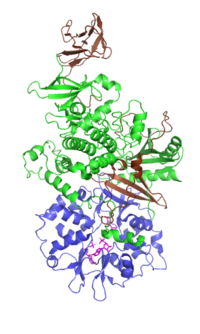
Photo from wikipedia
The Heme Regulated Inhibitor (HRI) is a key regulator of protein synthesis in mammalian cells. Once activated under heme-deficiency and other stress conditions, it phosphorylates the α subunit of eukaryotic… Click to show full abstract
The Heme Regulated Inhibitor (HRI) is a key regulator of protein synthesis in mammalian cells. Once activated under heme-deficiency and other stress conditions, it phosphorylates the α subunit of eukaryotic initiation factor 2 (eIF2α) leading to inhibition of protein synthesis. In the present study, our objective was to establish the structural and functional credentials of this kinase so as to qualify it as a stress responsive eIF2α kinase. When the catalytic kinase domain of the HRI (HRI.CKD) protein was subjected to high temperature, 45°C (above mammalian heat shock temperature), it could still phosphorylate the substrate, indicating its potential as a stress response kinase. At a temperature beyond 45°C, loss in secondary structure of the HRI.CKD is attributable to loss of its function. Furthermore, no significant structural changes were observed at the broad pH range of 3.0--10.0. The HRI.CKD incubated at any pH between 8.0-10.0, exhibited more than 60% of its kinase activity, demonstrating structural and functional stability of the kinase at an alkaline pH. These data taken together establish that the structural stability of this kinase at high temperature and alkaline conditions is due to conservation of its secondary structure and that the resulting functional activity qualifies this kinase as a stress responsive kinase.
Journal Title: International journal of biological macromolecules
Year Published: 2017
Link to full text (if available)
Share on Social Media: Sign Up to like & get
recommendations!